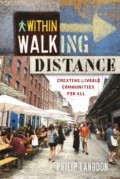Abstract
Janet Finegar was talking about the park in her neighborhood, and it was beginning to sound as if the park were a member of her family, maybe a precocious son or perhaps a daughter who was a musical prodigy. “My beloved child,” Finegar said more than once when describing Liberty Lands, a two-acre park that she, as much as anyone, had created from a wasteland of industrial rubble.
Notes
- 1.
To hear Finegar explain why she has focused on creating a neighborhood park, see “Liberty Lands Park in Philadelphia,” a brief video from One of Us Films, Oct. 5, 2012, https://vimeo.com/50837214. See also Elisa Lala, “Philadelphia’s Plethora of Pocket Parks,” PhillyVoice, Apr. 6, 2015, http://www.phillyvoice.com/phillys-plethora-pocket-parks/.
- 2.
My estimate of the size of Philadelphia is based on “Plan of the City of Philadelphia and Its Environs Shewing Its Improved Parts” by John Hills (Zebooker Collection, Athenaeum of Philadelphia, 1796), available at http://www.philageohistory.org/rdic-images/view-image.cfm/237-MP-019. At 5 minutes per quarter-mile (today’s rule of thumb for walking speed), it would have taken 54 minutes to cover the 2.7 miles from Federal Street in Southwark (Philadelphia’s southern edge in 1796) to Poplar Street in Northern Liberties. Because eighteenth-century streets were rougher-surfaced and slower-going than today’s, I added several minutes, bringing the trip to a little over an hour. The US Census reports that Philadelphia had a population of 28,522 in 1790 and 41,220 in 1800, second only to New York.
- 3.
Sam Bass Warner Jr., The Private City: Philadelphia in Three Periods of Its Growth (Philadelphia: University of Pennsylvania Press, 1968), p. 11.
- 4.
Le Corbusier, When the Cathedrals Were White (New York: McGraw-Hill Paperback Edition, 1964), p. 70. The book told about his 1935 trip to the United States and had its first English-language publication in 1947 in Great Britain. Better known is Le Corbusier’s The Radiant City, a 1935 book that influenced urban planning worldwide.
- 5.
For a succinct and somewhat critical summary of Le Corbusier’s insistence on strict segregation of uses, see Gili Merin, “AD Classics: Ville Radieuse/Le Corbusier,” Arch Daily Classics, Aug. 11, 2013, http://www.archdaily.com/411878/ad-classics-ville-radieuse-le-corbusier/.
- 6.
Peter Norton, Fighting Traffic: The Dawn of the Motor Age in the American City (Cambridge, MA: MIT Press, 2008), pp. 249–51.
- 7.
My first major article on the compact-development trend was “A Good Place to Live,” the cover story of the March 1988 Atlantic Monthly.
- 8.
“Take Advantage of Compact Building Design: Highlands’ Garden Village, Denver, Colorado,” US Environmental Protection Agency, last updated Mar. 29, 2016, https://www.epa.gov/smartgrowth/take-advantage-compact-building-design-highlands-garden-village-denver-colorado.
Rights and permissions
Copyright information
© 2017 Philip Langdon
About this chapter
Cite this chapter
Langdon, P. (2017). Introduction. In: Within Walking Distance. Island Press, Washington, DC. https://doi.org/10.5822/978-1-61091-773-5_1
Download citation
DOI: https://doi.org/10.5822/978-1-61091-773-5_1
Publisher Name: Island Press, Washington, DC
Print ISBN: 978-1-61091-868-8
Online ISBN: 978-1-61091-773-5
eBook Packages: Earth and Environmental ScienceEarth and Environmental Science (R0)

